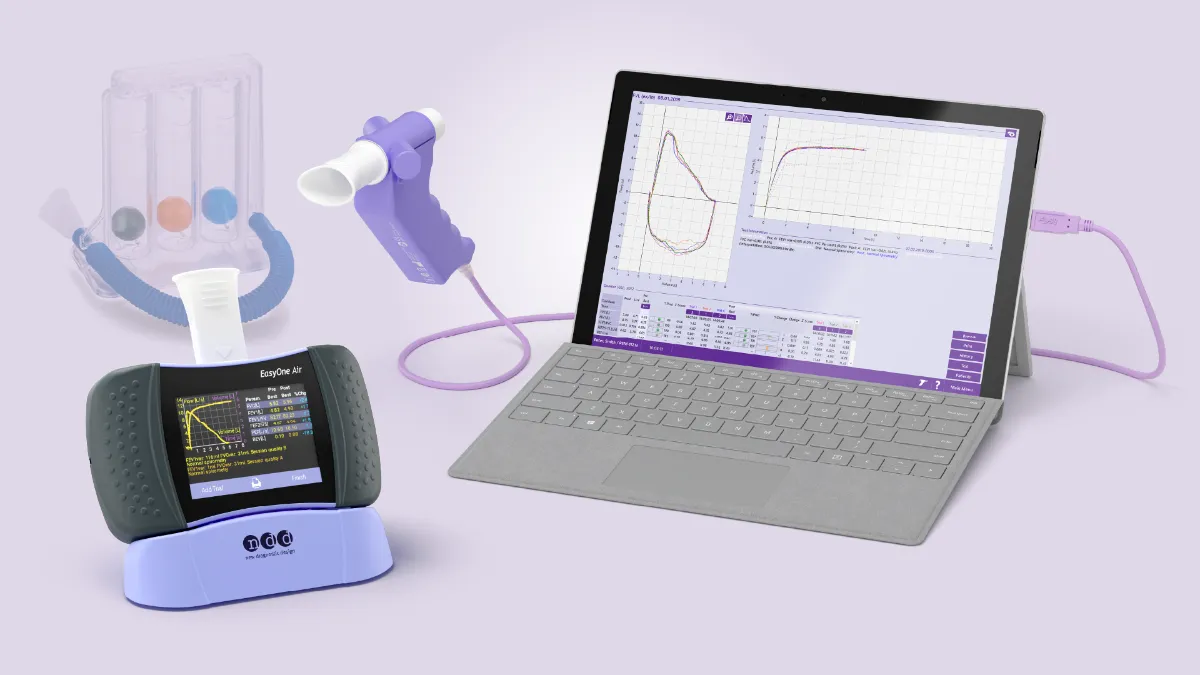The role of spirometry in asthma management: A comprehensive guide

Spirometry is a non-invasive lung function test that measures the amount and speed of air a patient blows out.1It is a valuable tool in the comprehensive management of asthma, contributing to accurate diagnosis, personalized treatment plans, and effective monitoring of lung function over time.
To better understand spirometry’s important role in asthma diagnosis and management, let’s first take a closer look at asthma and its triggers and symptoms.
Understanding asthma #
The Global Initiative for Asthma describes asthma as “a common, chronic respiratory disease affecting 1-29% of the population in different countries”.2 While asthma affects people of all ages, it is the leading chronic disease among children.1 With a disease so widespread, many of us have heard of asthma, but what is it really?
Asthma is a disease in which the airways narrow temporarily or permanently making it difficult to breathe.3When an overreactive immune system is combined with certain triggers, tensing of muscles around the airways, inflammation of the mucous membranes, and production of thick sticky mucus may occur.4
Triggers fall into two categories—allergic or extrinsic asthma and non-allergic or intrinsic asthma.5Extrinsic asthma is related to external allergens such as pollen, dust mites, animal fur, and cigarette smoke. Intrinsic asthma, on the other hand, is not allergy-related and stems from internal factors such as bacterial and viral inflammations, certain painkillers, and even stress. Someone with asthma symptoms could experience triggers across both categories.
Those with asthma usually experience symptoms in what we call episodes or attacks.3 These can occur anytime, but they often happen at night. Asthma symptoms may present differently depending on age. While symptoms such as coughing, whistling, and wheezing when breathing are common in children, additional symptoms of breathlessness during exercise or in general, and chest tightness may occur in teenagers and adults.
Timely diagnosis and monitoring of asthma are critical for proper treatment and can decrease the frequency and severity of symptoms.1 Diagnosis occurs after a physical exam and a discussion with a doctor on symptoms, medical history, and lifestyle.
For treatment, medication is prescribed based on the severity of symptoms.6 Exercise and breathing techniques used in conjunction with medication may also be beneficial. Patients can also try to avoid asthma triggers, if possible.
A written asthma management plan, created by the healthcare provider, patient, and parent or guardian, pulls together treatment information and is a helpful reference for the patient to self-manage their asthma.7
Finally, follow-up care allows the patient and health care provider to monitor and manage asthma over time.8
By understanding asthma triggers and symptoms and adhering to treatment and monitoring, patients can live their fullest, most normal life possible.
Role of spirometry in asthma diagnosis #
According to the recommendations of the National Asthma Education and Prevention Program,
asthma management consists of four components essential for care.9 The first component is assessment and monitoring in which the following key clinical activities occur: an asthma diagnosis is established, the severity of asthma is classified, follow-up care is scheduled, and, if needed, a referral to special care is given. Spirometry plays a critical role in these steps.
Spirometry in asthma management occurs:
- At initial assessment
- After treatment is initiated and symptoms have stabilized
- During times of progressive or prolonged asthma exacerbations
- At least every 1-2 years and more frequently depending on therapy response
As part of the initial assessment, lung function is measured with spirometry. Testing at this stage, before treatment, is important because the healthcare provider can more accurately confirm a diagnosis then rather than later in the process when the patient has already improved.2 The results of the spirometry test, combined with signs and symptoms, then determine the severity classification ranging from mild intermittent asthma to severe persistent asthma.8Classification plays a key role in determining the appropriate level of treatment.10
Due to possible changes in asthma severity, follow-up care is scheduled for ongoing management and monitoring.8During that time, spirometry can detect early signs of worsening asthma, allowing for prompt intervention and preventing severe exacerbations. This is particularly important for individuals with poorly controlled asthma. Spirometry is recommended at least every one to two years following treatment and can be used more frequently to monitor asthma.8
EasyOne spirometers for asthma management #
Spirometry plays a vital role in every stage of asthma management from initial assessment to stabilization to progressive exacerbations and beyond. Its early detection of worsening asthma leads to prompt intervention and minimizes impacts on those with asthma allowing them to live their fullest lives.
Discover the EasyOne Air and Easy on-PC spirometry devices for your allergy practice today.
Asthma: Overview [Internet]. Nih.gov. Institute for Quality and Efficiency in Health Care (IQWiG); 2017. Available from: https://www.ncbi.nlm.nih.gov/books/NBK279520/
Pg 3 ↩︎ ↩︎ ↩︎Global Initiative for Asthma. Global Strategy for Asthma Management and Prevention [Internet]. 2023. Available from: https://ginasthma.org/wp-content/uploads/2023/07/GINA-2023-Full-report-23_07_06-WMS.pdf
Pg 22 ↩︎ ↩︎Asthma: Overview [Internet]. Nih.gov. Institute for Quality and Efficiency in Health Care (IQWiG); 2017. Available from: https://www.ncbi.nlm.nih.gov/books/NBK279520/
Pg 1 ↩︎ ↩︎Asthma: Overview [Internet]. Nih.gov. Institute for Quality and Efficiency in Health Care (IQWiG); 2017. Available from: https://www.ncbi.nlm.nih.gov/books/NBK279520/
Pg 2 ↩︎Asthma: Overview [Internet]. Nih.gov. Institute for Quality and Efficiency in Health Care (IQWiG); 2017. Available from: https://www.ncbi.nlm.nih.gov/books/NBK279520/
Pg 1-2 ↩︎Asthma: Overview [Internet]. Nih.gov. Institute for Quality and Efficiency in Health Care (IQWiG); 2017. Available from: https://www.ncbi.nlm.nih.gov/books/NBK279520/
Pg 3-4 ↩︎National Asthma Education and Prevention Program of the National Heart, Lung, and Blood Institute, and the National Center for Environmental Health of the Centers for Disease Control and Prevention. Key Clinical Activities for Quality Asthma Care: Recommendations of the National Asthma Education and Prevention Program [Internet]. CDC.gov. Reproduced from the Morbidity and Mortality Weekly Report (MMWR): Recommendations and Reports, Vol. 52/No. RR-6, March 28, 2003.
Available from: https://www.cdc.gov/asthma/
Pg 7 ↩︎National Asthma Education and Prevention Program of the National Heart, Lung, and Blood Institute, and the National Center for Environmental Health of the Centers for Disease Control and Prevention. Key Clinical Activities for Quality Asthma Care: Recommendations of the National Asthma Education and Prevention Program [Internet]. CDC.gov. Reproduced from the Morbidity and Mortality Weekly Report (MMWR): Recommendations and Reports, Vol. 52/No. RR-6, March 28, 2003.
Available from: https://www.cdc.gov/asthma/
Pg 4 ↩︎ ↩︎ ↩︎ ↩︎National Asthma Education and Prevention Program of the National Heart, Lung, and Blood Institute, and the National Center for Environmental Health of the Centers for Disease Control and Prevention. Key Clinical Activities for Quality Asthma Care: Recommendations of the National Asthma Education and Prevention Program [Internet]. CDC.gov. Reproduced from the Morbidity and Mortality Weekly Report (MMWR): Recommendations and Reports, Vol. 52/No. RR-6, March 28, 2003.
Available from: https://www.cdc.gov/asthma/
Pg 2-5 ↩︎Global Initiative for Asthma. Global Strategy for Asthma Management and Prevention [Internet]. 2023. Available from: https://ginasthma.org/wp-content/uploads/2023/07/GINA-2023-Full-report-23_07_06-WMS.pdf
Pg 26 ↩︎
Written by

Kelly Sicard
MA
Kelly M. Sicard is a freelance writer with an M.A. in English & Creative Writing who spent over a decade working for a non-profit lung health organization. She lives in New Hampshire with her husband, daughter, and black labrador and enjoys reading, writing, listening to stories, appreciating nature, and spending time with family.








